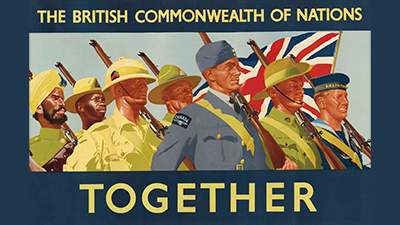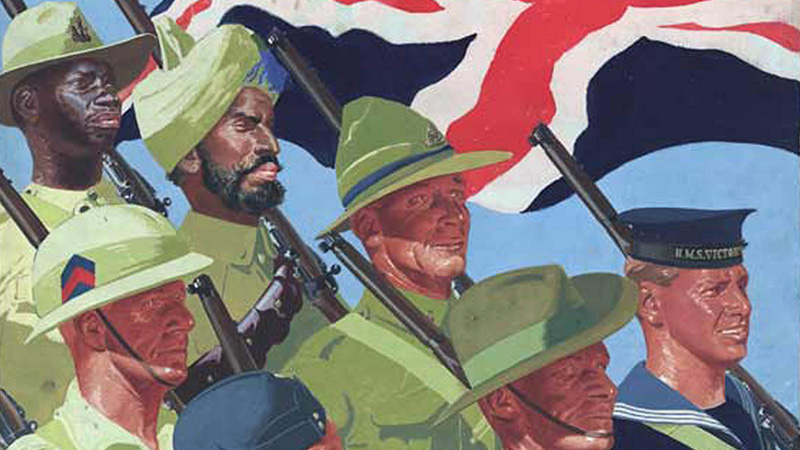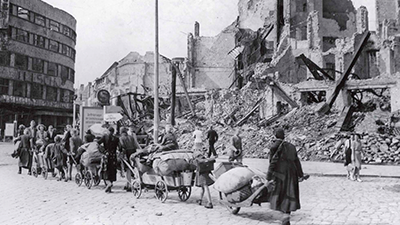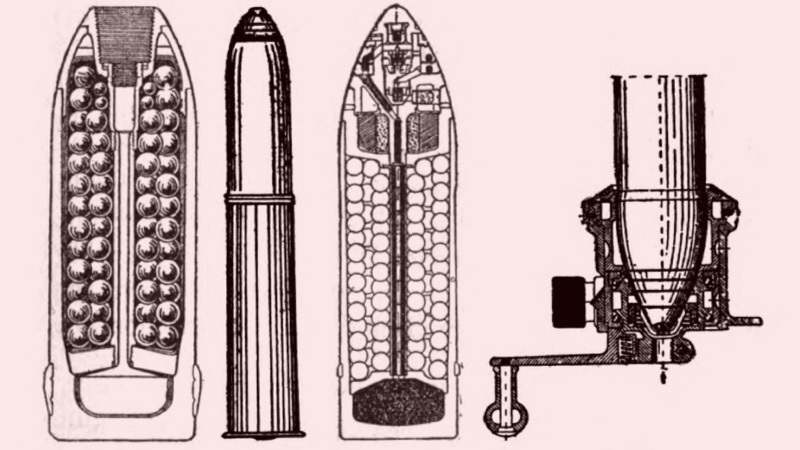Conducting World War II
Teacher Resources
Driving Question: How did governments use various strategies to conduct World War II, and what similarities and differences emerged in their approaches?
Just over twenty years after the curtains closed on the First World War, the world was yet again embroiled in a global conflict. As a historian, you may already have noticed that this could be described as a disastrous and deadly continuation of a conflict that started in 1914. With new military tactics and technology, the Second World War proved to be even more destructive and devastating than the first.
Learning Objectives
- Explain similarities and differences in how governments used a variety of methods to conduct war.
- Assess how new weapons led to mass atrocities and increased global tensions.
- Use the historical reasoning process of causation to understand the causes and consequences of World War II.
- Analyze primary source documents to evaluate how governments conducted war and how people responded to these methods after 1900.
- Analyze primary source documents to evaluate the advancement of science and technology in the era of global conflict.
Vocab Terms:
- antisemitism
- atrocity
- casualty
- concentration camp
- genocide
- nuclear
- rationing
Closer: Conducting World War II
To teach this lesson step, refer to page 15 of the Lesson 7.7 Teaching Guide.
Looking for A Slightly Different Twist on Claim Testing – Global Conflict? Look no further than this Community Forum thread.
There are many opinions about World War II. Come up with your own—and defend them with evidence.
Opener: Conducting World War II
To teach this lesson step, refer to page 3 of the Lesson 7.7 Teaching Guide.
The Data Literacy Guide has clear strategies to help teach data literacy and build student confidence with data visualizations.
You’ll make short work of short answer questions with this Unit 7 SAQ practice!
Economics in the Second World War
To teach this lesson step, refer to page 6 of the Lesson 7.7 Teaching Guide.
War and money go hand-in-hand. World War II was a total war, which required the full economic effort of the societies it involved.
-
Guiding Questions
-
Before you read
Preview the questions below, and then skim the article. Be sure to look at the section headings and any images.
While you read
Look for answers to these questions:
- How does the author define a “total war economy”?
- What was Japan’s motivation for conquering and colonizing in Asia?
- Why did the Soviet Union have an advantage in directing resources toward a total war economy?
- How did the outbreak of war affect the US economy?
- Japan and Britain are both small island nations. Why did the British not have to invade and conquer in order to supply its war effort?
After you read
Respond to the following questions:
- To what extent does this article explain the similarities and differences in how governments used a variety of methods to conduct war?
- Using the economic systems theme narrative, explain how the Industrial Revolution helped the Allies win the war.
- What developments during the long nineteenth century gave the Allied powers an advantage in this twentieth-century conflict?
Source Collection: World War II
To teach this lesson step, refer to page 7 of the Lesson 7.7 Teaching Guide.
The more things change, the more they stay the same…, or do they? Find out using these World War II era primary sources! As you read the source excerpts in this collection, use the accompanying Quick-Sourcing Tool and activity to guide your analysis.
Argument Builder
Now that you’ve explored the many causes of the Second World War, consider: could it have all been avoided?
Thirty Years of Continuous War
To teach this lesson step, refer to page 7 of the Lesson 7.7 Teaching Guide.
The traditional story of the two world wars goes like this: The First World War begins and ends in about four years, there’s a gap of about twenty years, and then the Second World War begins, and ends six years later. But what if it makes more sense to study the two world wars and the period in between as a single, connected, 30-year conflict?
-
Guiding Questions
-
Before you read
Preview the questions below, and then skim the article. Be sure to look at the section headings and any images.
While you read
Look for answers to these questions:
- How was nationalism an important thread connecting the two world wars?
- How were empires and colonialism continuities connecting the two world wars?
- How did the treatment of Germany following the First World War help lead to the Second World War?
After you read
Respond to the following questions:
- Do you agree with the author’s assertion that we should treat the period 1914–1945 as a single “continuous war”? Why, or why not?
- What is the utility of breaking out of the normal view of World War I and World War II as two separate conflicts? How does viewing them as one war help us to understand this period better? How does it limit us?
CCOT: Consequences of Industrialization to Global Conflict
To teach this lesson step, refer to page 8 of the Lesson 7.7 Teaching Guide.
It’s hard to improve without feedback. Check on your student’s CCOT progress using the CCOT: Feedback Form.
Examine the continuities and changes between Unit 6: Consequences of Industrialization and Unit 7: Global Conflict to craft thesis statements and compose a multi-paragraph response to a CCOT prompt.
The Fallen of World War II
To teach this lesson step, refer to page 12 of the Lesson 7.7 Teaching Guide.
Curious about how other teachers approach this video? Read World War II in the Community Forum.
War is destructive, leaving countless victims in its path. World War II was especially destructive. What factors led to the increased intensity of the conflict’s devastation?
-
Guiding Questions
-
Before you watch
Preview the questions below, and then review the transcript.
While you watch
Look for answers to these questions:
- What was the general profile of people who made up military deaths, as opposed to civilian deaths?
- In which military campaign did the most Germans lose their lives?
- What country lost the most casualties as a percentage of its population?
- Who lost the most soldiers and civilians in the war and why?
- Which sides purposely targeted civilians during World War II? Give some examples.
- Was World War II the deadliest war in history?
- What does this video mean by the “Long Peace”?
After you watch
Respond to the following questions:
- To what extent does this video explain the causes and consequences of World War II?
- The video concludes that, since World War II, large conflicts have been less common and less deadly. How do you explain this trend?
- Do you think World War II was the most devastating event in world history? Why or why not?
Key Ideas
Nuclear Weapons
To teach this lesson step, refer to page 13 of the Lesson 7.7 Teaching Guide.
Nuclear weapons changed the face of war—and, in fact, the world. This article will help explain how we entered the nuclear age and examine the historical debates surrounding President Truman’s decision to drop the bomb.
-
Guiding Questions
-
Before you read
Preview the questions below, and then skim the article. Be sure to look at the section headings and any images.
While you read
Look for answers to these questions:
- Where was nuclear fission discovered? How did it get into the hands of the United States’ military?
- What was the Potsdam Declaration?
- According to Peter Zimmerman, Japanese cities were being bombed every week, with about as many people dying every week as died as a result of the nuclear bomb attack on Hiroshima. What claim does this evidence support?
- Why did the Japanese surrender, according to Tsuyoshi Hasegawa?
- What “race” did the United States, Soviet Union, United Kingdom, China, France, and India participate in after the Second World War?
After you read
Respond to the following questions:
- Using evidence, explain how this article helps you understand the consequences of World War II.
- Tsuyoshi Hasegawa argues that the Soviet Union played a considerable role in Japan’s surrender, more so than the US use of nuclear weapons. Do you find the author’s argument convincing? Why or why not? Use evidence from materials from this unit to support your claim.
Source Collection: Science and Technology in the World Wars
To teach this lesson step, refer to page 14 of the Lesson 7.7 Teaching Guide.
Want to do more than quick source? The Sourcing Tool can help you and your students dig deeper into this practice.
Technology can often make our lives easier and more comfortable. It can also massively affect the way we fight wars. As you read the source excerpts in this collection, use the accompanying Quick-Sourcing Tool and activity to guide your analysis








